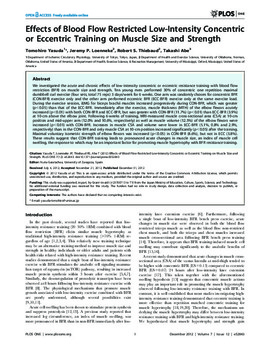| dc.contributor.author | Tomohiro Yasuda | en_US |
| dc.contributor.author | Jeremy P. Loenneke | en_US |
| dc.contributor.author | Robert S. Thiebaud | en_US |
| dc.contributor.author | Takashi Abe | en_US |
| dc.date.accessioned | 2015-01-23T17:17:43Z | |
| dc.date.accessioned | 2016-03-30T15:36:20Z | |
| dc.date.available | 2015-01-23T17:17:43Z | |
| dc.date.available | 2016-03-30T15:36:20Z | |
| dc.date.issued | 2012-12-31 | en_US |
| dc.identifier.citation | Yasuda T, Loenneke JP, Thiebaud RS, Abe T (2012) Effects of Blood Flow Restricted Low-Intensity Concentric or Eccentric Training on Muscle Size and Strength. PLoS ONE 7(12): e52843. doi:10.1371/journal.pone.0052843 | en_US |
| dc.identifier.uri | https://hdl.handle.net/11244/14087 | |
| dc.description | The authors thank the students who participated in this study. We also thank Toshiaki Nakajima, MD, PhD, Ken Masamune, PhD, Hiroki Kamiuchi, The University of Tokyo, for helpful discussion and technical support. | en_US |
| dc.description | Conceived and designed the experiments: TY TA. Performed the experiments: TY. Analyzed the data: TY JPL TA. Wrote the paper: TY JPL RST TA. | en_US |
| dc.description.abstract | We investigated the acute and chronic effects of low-intensity concentric or eccentric resistance training with blood flow restriction (BFR) on muscle size and strength. Ten young men performed 30% of concentric one repetition maximal dumbbell curl exercise (four sets, total 75 reps) 3 days/week for 6 weeks. One arm was randomly chosen for concentric BFR (CON-BFR) exercise only and the other arm performed eccentric BFR (ECC-BFR) exercise only at the same exercise load. During the exercise session, iEMG for biceps brachii muscles increased progressively during CON-BFR, which was greater (p<0.05) than that of the ECC-BFR. Immediately after the exercise, muscle thickness (MTH) of the elbow flexors acutely increased (p<0.01) with both CON-BFR and ECC-BFR, but was greater with CON-BFR (11.7%) (p<0.01) than ECC-BFR (3.9%) at 10-cm above the elbow joint. Following 6-weeks of training, MRI-measured muscle cross-sectional area (CSA) at 10-cm position and mid-upper arm (12.0% and 10.6%, respectively) as well as muscle volume (12.5%) of the elbow flexors were increased (p<0.01) with CON-BFR. Increases in muscle CSA and volume were lower in ECC-BFR (5.1%, 0.8% and 2.9%, respectively) than in the CON-BFR and only muscle CSA at 10-cm position increased significantly (p<0.05) after the training. Maximal voluntary isometric strength of elbow flexors was increased (p<0.05) in CON-BFR (8.6%), but not in ECC (3.8%). These results suggest that CON-BFR training leads to pronounced acute changes in muscle size, an index of muscle cell swelling, the response to which may be an important factor for promoting muscle hypertrophy with BFR resistance training. | en_US |
| dc.language.iso | en_US | en_US |
| dc.publisher | PLos One | en_US |
| dc.relation.ispartofseries | PLoS ONE 7(12):e52843 | en_US |
| dc.relation.uri | http://www.plosone.org/article/info%3Adoi%2F10.1371%2Fjournal.pone.0052843 | en_US |
| dc.rights | Attribution 3.0 United States | en_US |
| dc.rights.uri | https://creativecommons.org/licenses/by/3.0/us/ | en_US |
| dc.subject | PLOS | en_US |
| dc.subject | Public Library of Science | en_US |
| dc.subject | Open Access | en_US |
| dc.subject | Open-Access | en_US |
| dc.subject | Science | en_US |
| dc.subject | Medicine | en_US |
| dc.subject | Biology | en_US |
| dc.subject | Research | en_US |
| dc.subject | Peer-review | en_US |
| dc.subject | Inclusive | en_US |
| dc.subject | Interdisciplinary | en_US |
| dc.subject | Ante-disciplinary | en_US |
| dc.subject | Physics | en_US |
| dc.subject | Chemistry | en_US |
| dc.subject | Engineering | en_US |
| dc.title | Effects of Blood Flow Restricted Low-Intensity Concentric or Eccentric Training on Muscle Size and Strength | en_US |
| dc.type | Research Article | en_US |
| dc.description.peerreview | Yes | en_US |
| dc.description.peerreviewnotes | http://www.plosone.org/static/editorial#peer | en_US |
| dc.identifier.doi | 10.1371/journal.pone.0052843 | en_US |
| dc.rights.requestable | false | en_US |

